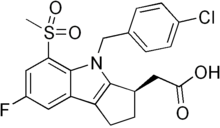- Laropiprant
-
Laropiprant 
Systematic (IUPAC) name (-)-[(3R)-4-(4-chlorobenzyl)-7-fluoro-5-(methylsulfonyl)-1,2,3,4-tetrahydrocyclopenta[b]indol-3-yl]acetic acid Clinical data AHFS/Drugs.com International Drug Names Licence data EMA:Link Pregnancy cat. ? Legal status ? Routes Oral Identifiers CAS number 571170-77-9 
ATC code C10AD52
(combination with niacin)UNII G7N11T8O78 
KEGG D08940 
ChEMBL CHEMBL426559 
Synonyms MK-0524A Chemical data Formula C21H19ClFNO4S Mol. mass 435.90 g/mol  (what is this?) (verify)
(what is this?) (verify)Laropiprant (INN) is used in combination with niacin to reduce blood cholesterol (LDL and VLDL). Merck & Co. planned to market this combination under the trade names Cordaptive and Tredaptive. On April 28, 2008, the U.S. Food and Drug Administration (FDA) issued a "not approved" letter for Cordaptive.[1] Tredaptive was approved by the European Medicines Agency (EMA) on July 3, 2008.[2]
Laropiprant itself has no cholesterol lowering effect, but it reduces facial flushes induced by niacin. In a trial with 1613 patients, 10.2% patients stopped taking the medication in the Cordaptive group versus 22.2% under niacin monotherapy.[3]
Tredaptive contains 1000 mg of niacin and 20 mg of laropiprant in each tablet.[4]
Mechanism of action
Niacin in cholesterol lowering doses (500–2000 mg per day) causes facial flushes by stimulating biosynthesis of prostaglandin D2, especially in the skin. PG D2 acts as a vasodilator via DP1 receptors, increasing blood flow and thus leading to flushes.[4][5]
Laropiprant acts as a DP1 antagonist, reducing the vasodilation.[4]
Taking 650 mg of aspirin 20–30 minutes prior to taking niacin has also been proven to prevent flushing in 90% of patients, presumably by suppressing prostaglandin synthesis,[6] but this medication also increases the risk of gastrointestinal bleeding,[7] though the increased risk is less than 1 percent.[8]
References
- ^ Carey, John (April 29, 2008). "FDA Rejects Merck's Cordaptive". BusinessWeek. http://www.businessweek.com/bwdaily/dnflash/content/apr2008/db20080429_182260.htm. Retrieved 2009-11-13.
- ^ "Tredaptive European Public Assessment Report". European Medicines Agency. http://www.emea.europa.eu/humandocs/Humans/EPAR/tredaptive/tredaptive.htm. Retrieved November 13, 2009.
- ^ Lai E, De Lepeleire I, Crumley TM, et al. (June 2007). "Suppression of niacin-induced vasodilation with an antagonist to prostaglandin D2 receptor subtype 1". Clin. Pharmacol. Ther. 81 (6): 849–57. doi:10.1038/sj.clpt.6100180. PMID 17392721.
- ^ a b c "Tredaptive Prescribing Information" (PDF). Merck & Co.. http://www.merck.com/newsroom/pdf/Tredaptive_pi.pdf. Retrieved 2009-11-14.
- ^ Sood, A.; Arora, R. (2009). "Mechanisms of Flushing Due to Niacin and Abolition of These Effects". The Journal of Clinical Hypertension 11 (11): 685. doi:10.1111/j.1559-4572.2008.00050.x. PMID 19878384.
- ^ Richard A. Kunin (1976). "The Action of Aspirin in Preventing the Niacin Flush and its Relevance to the Antischizophrenic Action of Megadose Niacin" (PDF). Orthomolecular Psychiatry 5 (2): 89–100. http://www.orthomolecular.org/library/jom/1976/pdf/1976-v05n02-p089.pdf. Retrieved 2009-11-14.
- ^ Sørensen HT, Mellemkjaer L, Blot WJ, et al. (September 2000). "Risk of upper gastrointestinal bleeding associated with use of low-dose aspirin". Am. J. Gastroenterol. 95 (9): 2218–24. doi:10.1111/j.1572-0241.2000.02248.x. PMID 11007221.
- ^ [1][dead link]
Lipid modifying agents (C10) GI tract Ezetimibe • SCH-48461Liver Simvastatin# • Atorvastatin • Fluvastatin • Lovastatin • Mevastatin • Pitavastatin • Pravastatin • Rosuvastatin • Cerivastatin‡Blood vessels CETP inhibitors (HDL)Combinations Other Dextrothyroxine • Probucol • Tiadenol • Benfluorex • Meglutol • Omega-3-triglycerides • Magnesium pyridoxal 5-phosphate glutamate • Policosanol • Lapaquistat§ • Alipogene tiparvovecCategories:- Merck
- Indoles
- Organochlorides
- Organofluorides
- Sulfones
Wikimedia Foundation. 2010.
